Search Results
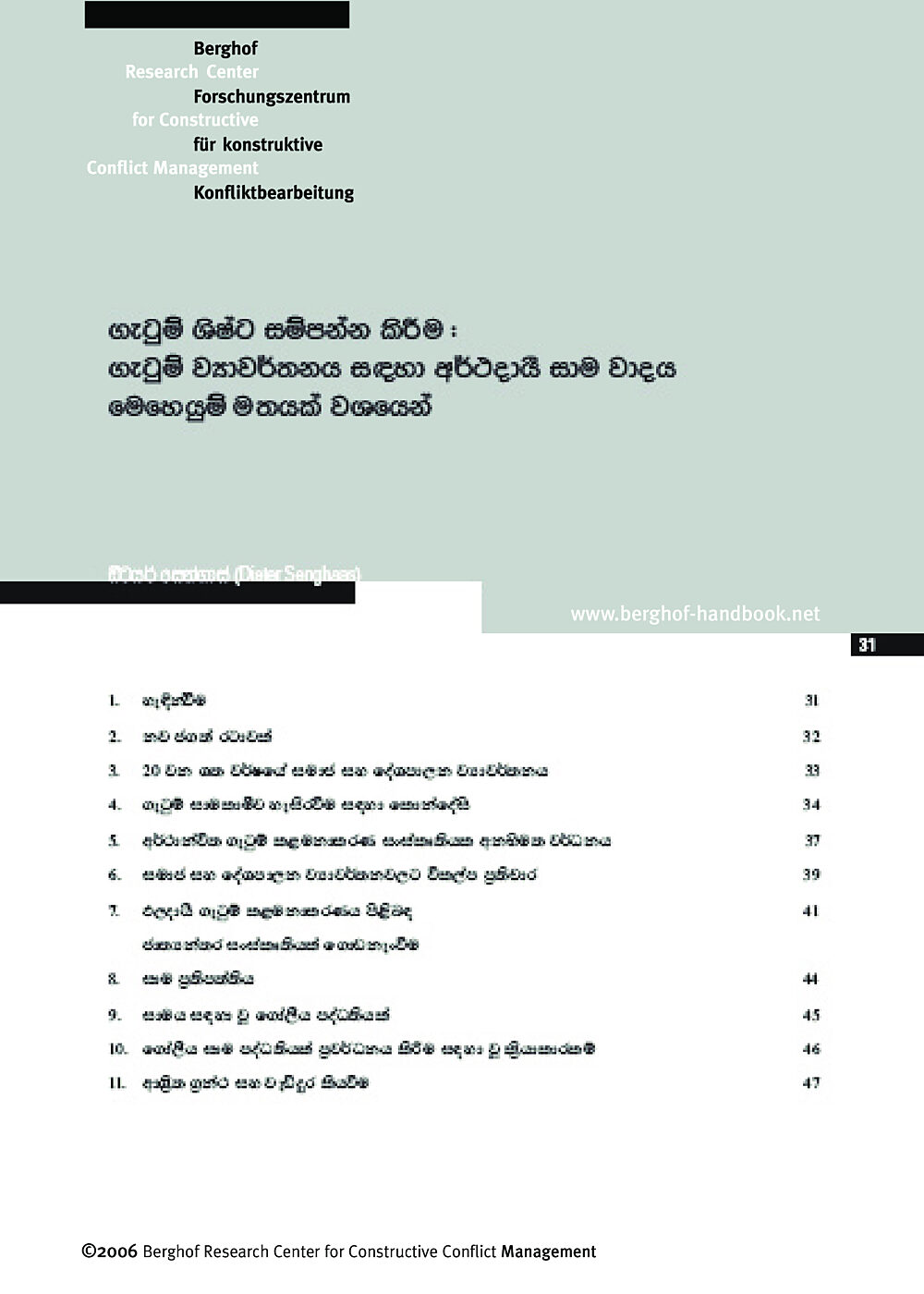
ගැටුම් ශිෂ්ටසම්පන්න කිරීම: ගැටුම් ව්යවර්තනය සඳහා අර්ථදායි සාමවාදය මෙහෙයුම් මතයක් වශයෙන්Handbook Article
[වියුක්ත යන්ත්ර-පරිවර්තනය] ගැටුම් ශිෂ් ized සම්පන්න කළමනාකරණය පිළිබඳ න්යායාත්මක ප්රශ්න සාකච්ඡා කරයි. කතුවරයා යෝජනා කරන්නේ සිවිල් හෝ ජාත්යන්තර යුද්ධය අරාජිකත්වයේ ප්රති result ලයක් නම් එය ආමන්ත්රණය කළ හැක්කේ ජාතික, කලාපීය හා ජාත්යන්තර මට්ටමින් ගොඩනඟන ලද සමාජ පිළිවෙලකට පමණක් බවයි. කතුවරයා සංකීර්ණ සාම ගෘහ නිර්මාණ ශිල්පයේ ආකෘතියක් ඉදිරිපත් කරයි, එනම් “ශිෂ්ටාචාර ෂඩාස්රය”. (2004 මුද්රණ සංස්කරණය සඳහා සංශෝධනය කරන ලදි)
- Year 2007
- Author(s) Dieter Senghaas
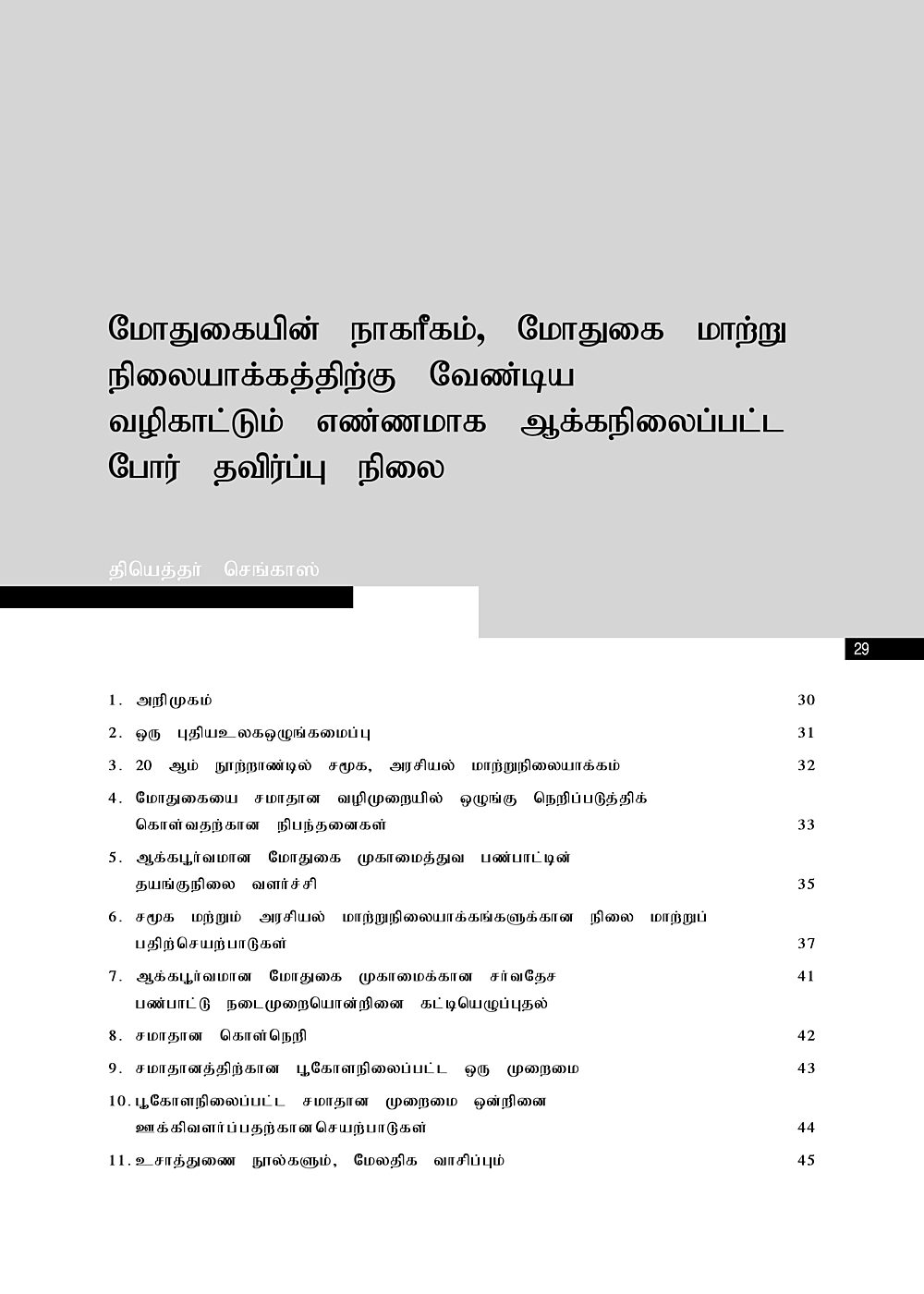
மோதுகையின் நாகரீகம், மோதுகை மாற்று நிலையாக்கத்திற்கு வேண்டிய வழிகாட்டும் எண்ணமாக ஆக்கநிலைப்பட்ட போர் தவிர்ப்பு நிலை.Handbook Article
[சுருக்கம் இயந்திரம்-மொழிபெயர்க்கப்பட்டுள்ளது] மோதல்களின் நாகரிக மேலாண்மை தொடர்பான தத்துவார்த்த கேள்விகளைப் பற்றி விவாதிக்கிறது. உள்நாட்டு அல்லது சர்வதேச யுத்தம் அராஜகத்தின் விளைவாக இருந்தால், அதை தேசிய, பிராந்திய மற்றும் சர்வதேச மட்டங்களில் கட்டமைக்கப்பட்ட ஒரு சமூக ஒழுங்கால் மட்டுமே தீர்க்க முடியும் என்று ஆசிரியர் முன்மொழிகிறார். ஆசிரியர் சிக்கலான அமைதி கட்டமைப்பின் மாதிரியை முன்வைக்கிறார், அதாவது "நாகரிக அறுகோணம்". (2004 அச்சு பதிப்பிற்காக திருத்தப்பட்டது)
- Year 2007
- Author(s) Dieter Senghaas
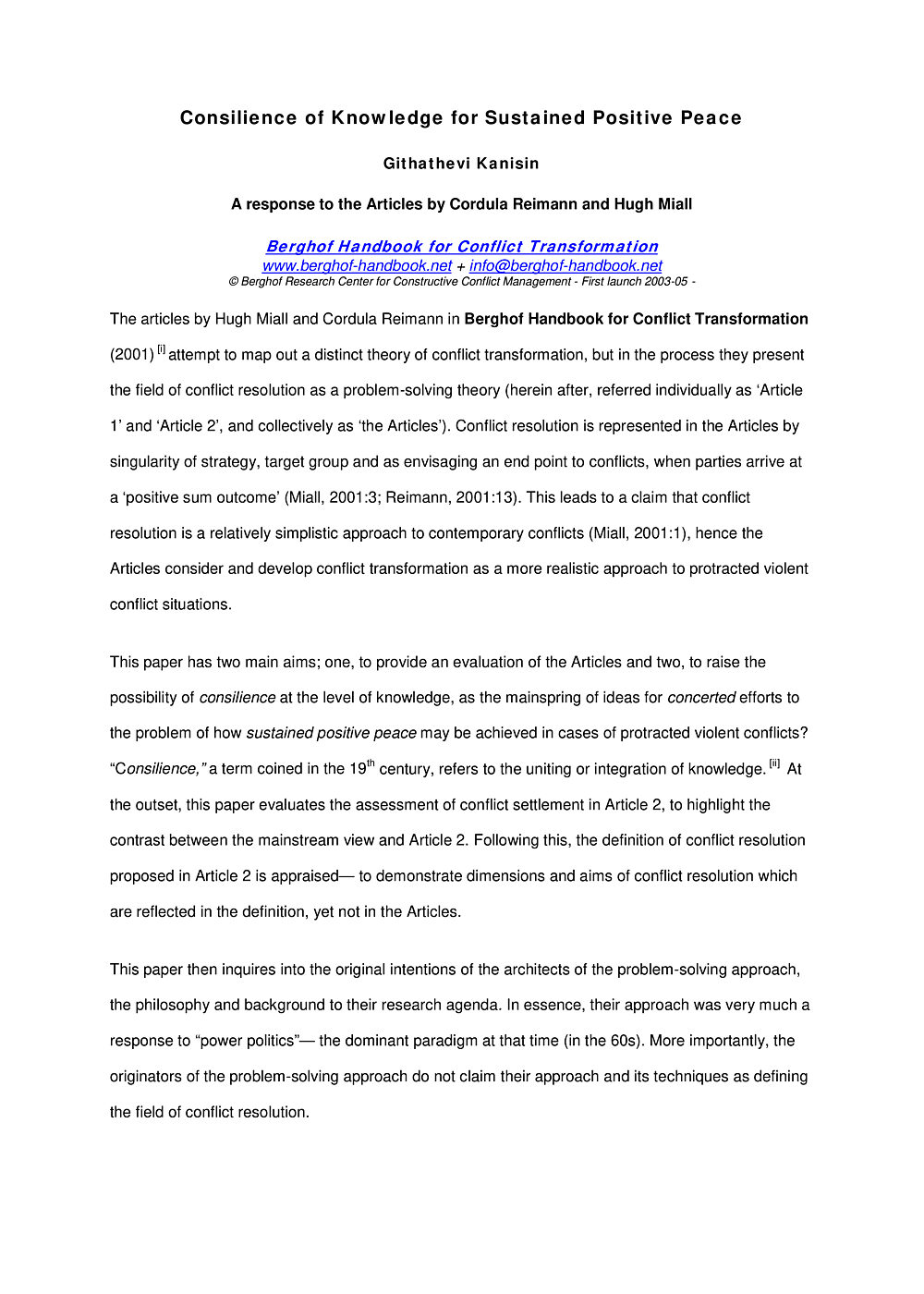
Consilience of Knowledge for Sustained Positive Peace: A response to the Articles by Cordula Reimann and Hugh MiallHandbook Article Response
The articles by Hugh Miall and Cordula Reimann in Berghof Handbook for Conflict Transformation (2001) attempt to map out a distinct theory of conflict transformation, but in the process they present the field of conflict resolution as a problem-solving theory (herein after, referred individually as ‘Article 1’ and ‘Article 2’, and collectively as ‘the Articles’). Conflict resolution is represented in the Articles by singularity of strategy, target group and as envisaging an end point to conflicts, when parties arrive at a ‘positive sum outcome’ (Miall, 2001:3; Reimann, 2001:13). This leads to a claim that conflict resolution is a relatively simplistic approach to contemporary conflicts (Miall, 2001:1), hence the Articles consider and develop conflict transformation as a more realistic approach to protracted violent conflict situations
- Year 2003
- Author(s) Githathevi Kanisin
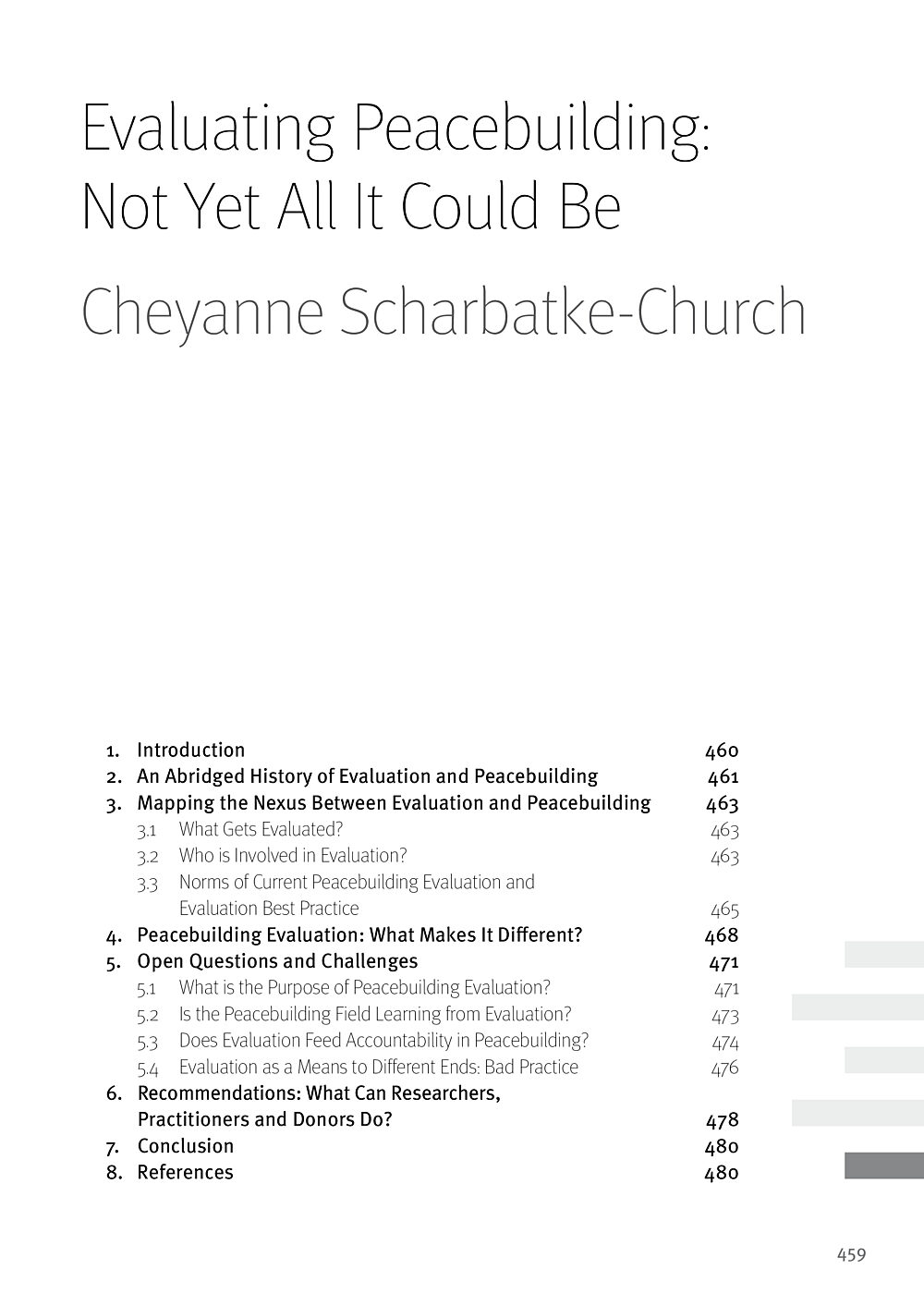
Evaluating Peacebuilding: Not Yet All It Could BeHandbook Article
- Year 2011
- Author(s) Cheyanne Scharbatke-Church
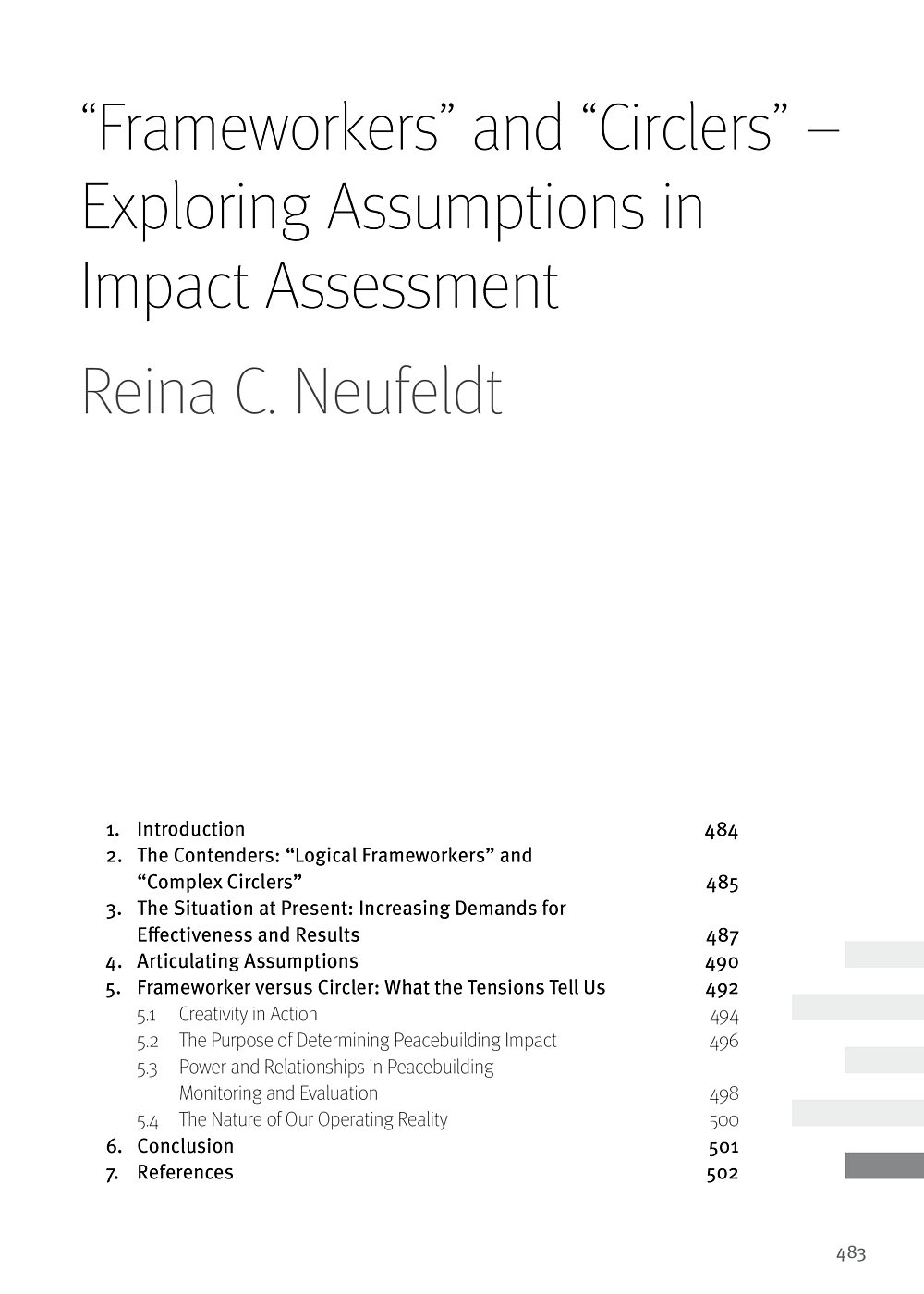
"Frameworkers" and "Circlers" – Exploring Assumptions in Impact AssessmentHandbook Article
Unpacks some of the hidden hypotheses underlying current assessment methodologies. The author argues that two (ideal type) constituencies interact – and sometimes clash – in development and peacebuilding work. She sets out to clarify their contending perspectives and illustrates ways in which both approaches can enrich each other and further the ultimate task of achieving effective impact monitoring and evaluation. (updated and revised for 2011 print edition)
- Year 2011
- Author(s) Reina C. Neufeldt
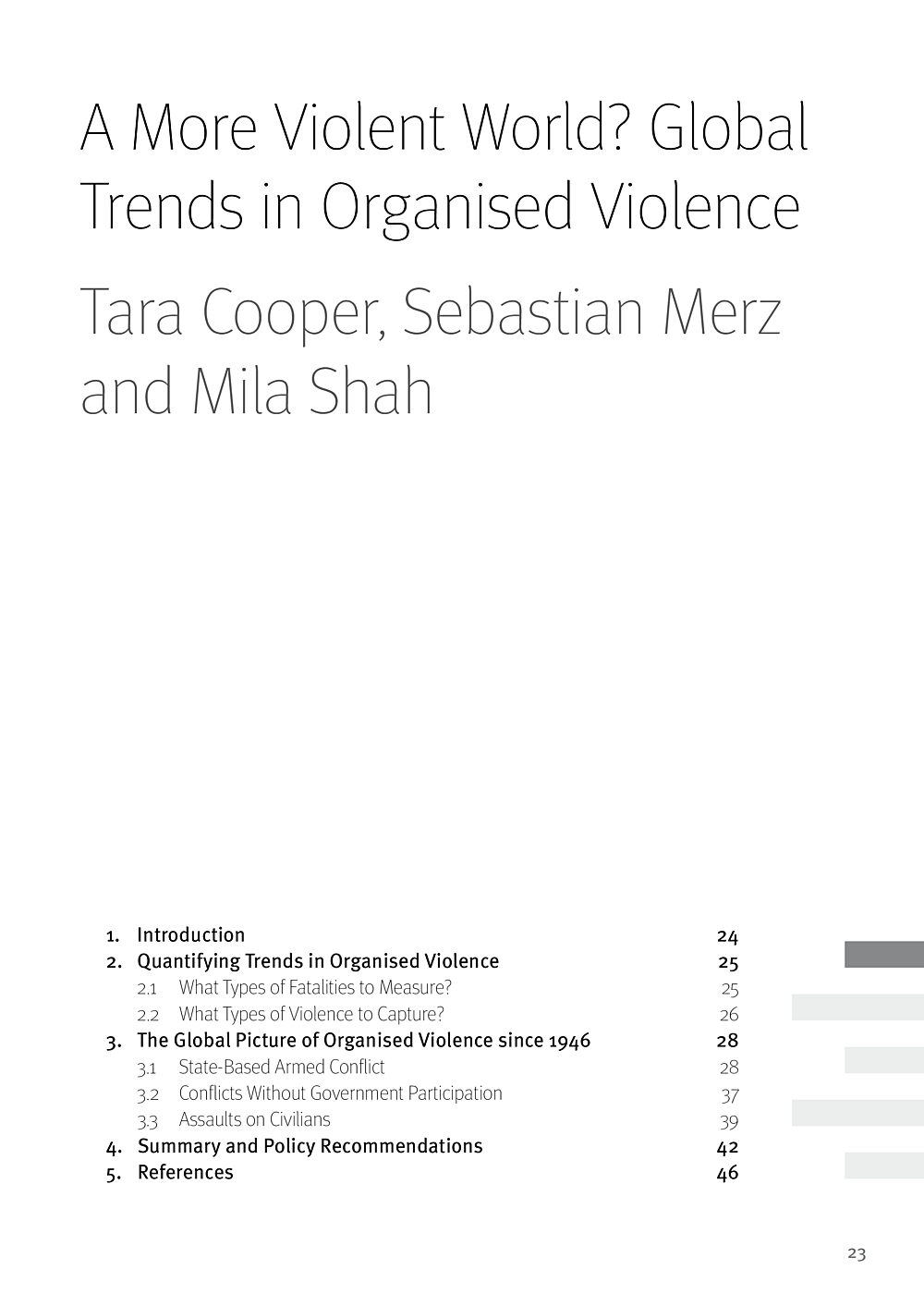
A More Violent World? Global Trends in Organised ViolenceHandbook Article
Presents robust quantitative data challenging the widespread notion that worldwide trends in violent conflict are increasing. This reflects changes in the nature of warfare, but also points to some possible successful outcomes of recent peacebuilding work. The analysis, conducted as part of the Human Security Report Project, extends beyond state-based conflicts to also cover non-state actors involved in conflict and assaults that target civilians.
- Year 2011
- Author(s) Tara Cooper, Sebastian Merz, Mila Shah
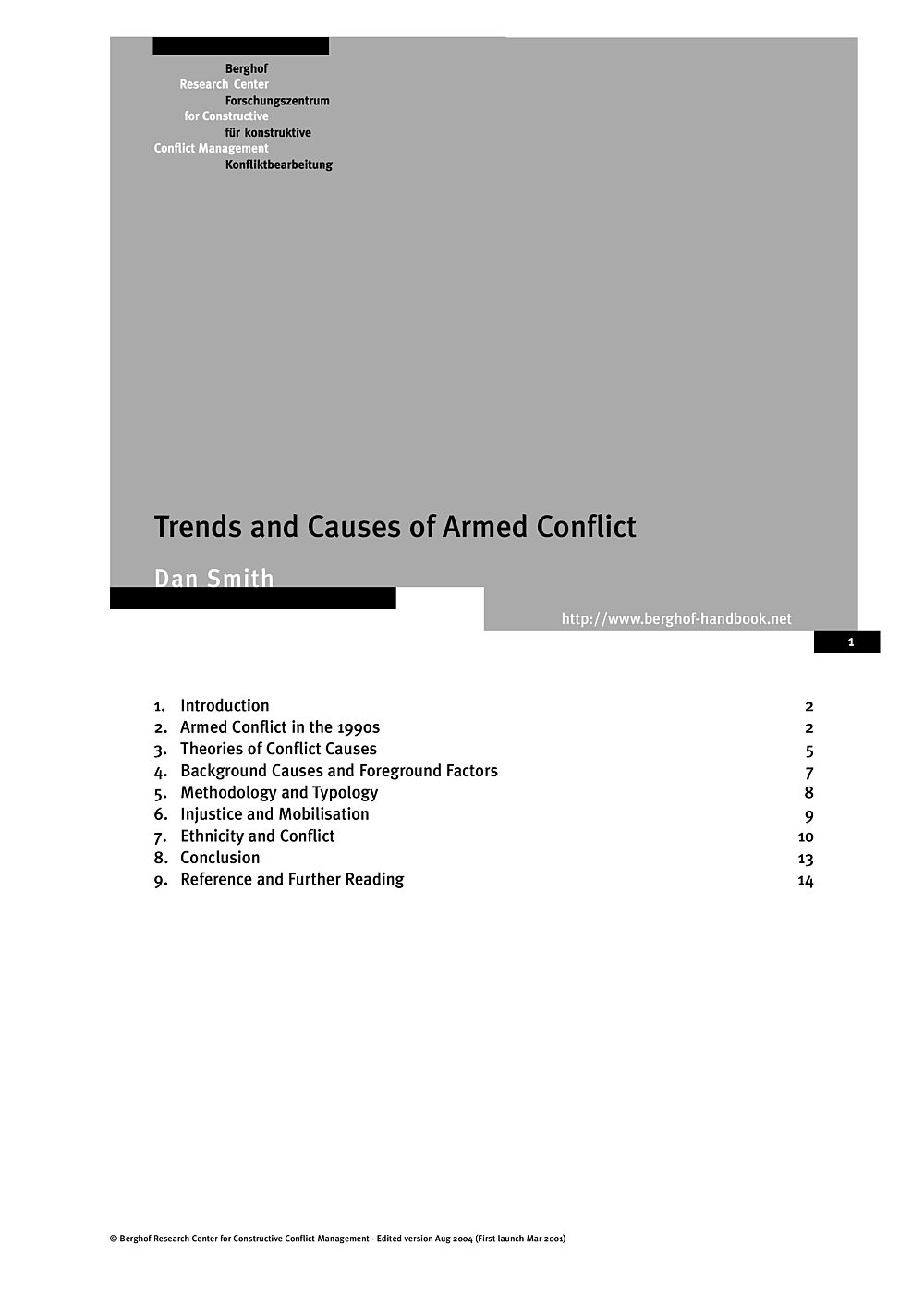
Trends and Causes of Armed ConflictHandbook Article
Gives an overview of current findings on causes of armed conflict, identifying injustice and mobilisation as key concepts. The author shares insights on where to look for signs of potential escalation, where to seek and how to utilise opportunities for preventing violent escalation. (revised for 2004 print edition)
- Year 2004
- Author(s) Dan Smith
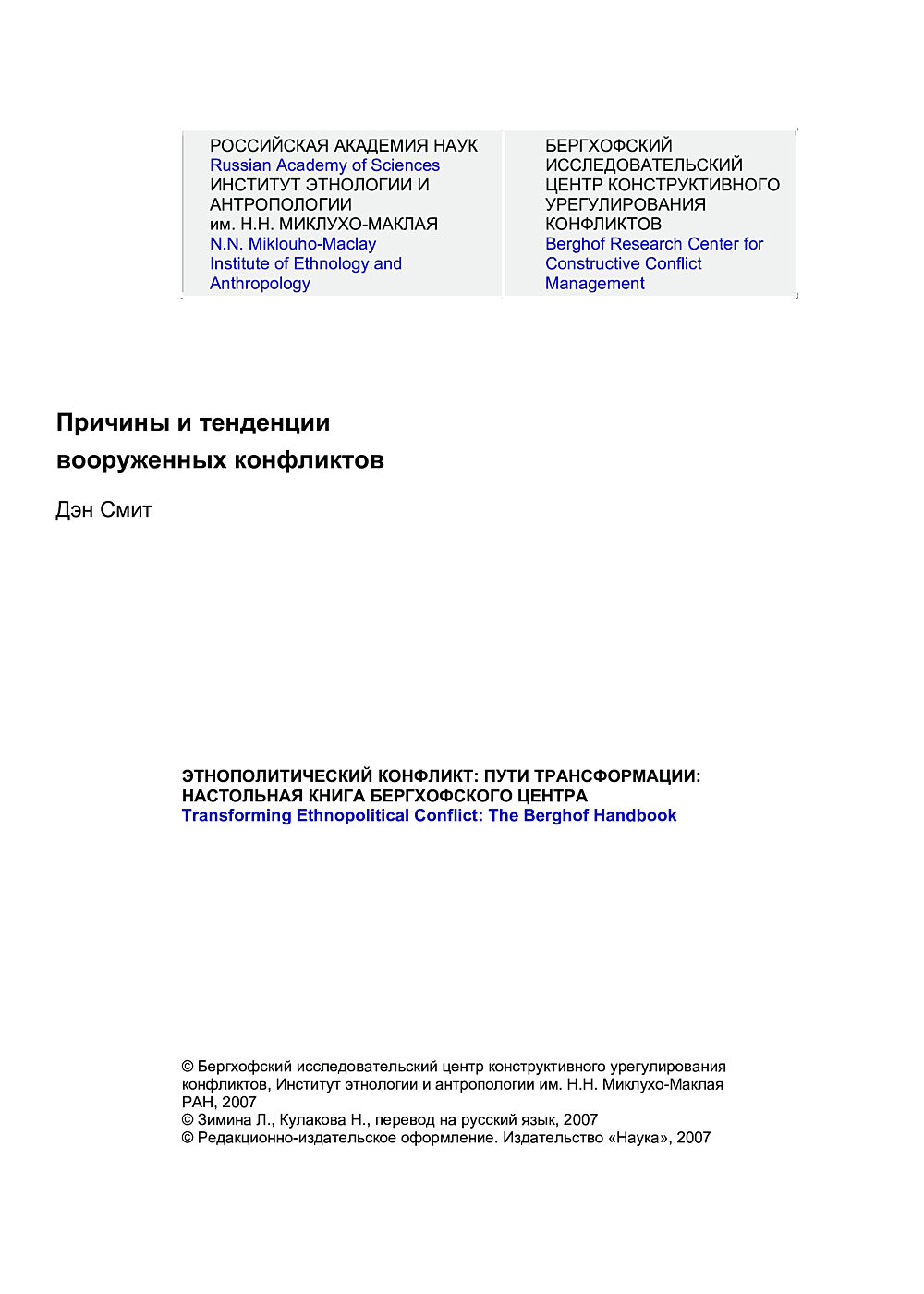
Причины и тенденции вооруженных конфликтовHandbook Article
[Аннотация машинный перевод] Дает обзор текущих результатов о причинах вооруженного конфликта, определяя несправедливость и мобилизацию в качестве ключевых понятий. Автор делится мнениями о том, где искать признаки потенциальной эскалации, где искать и как использовать возможности для предотвращения эскалации насилия. (переработано для печатного издания 2004 г.)
- Year 2007
- Author(s) Dan Smith
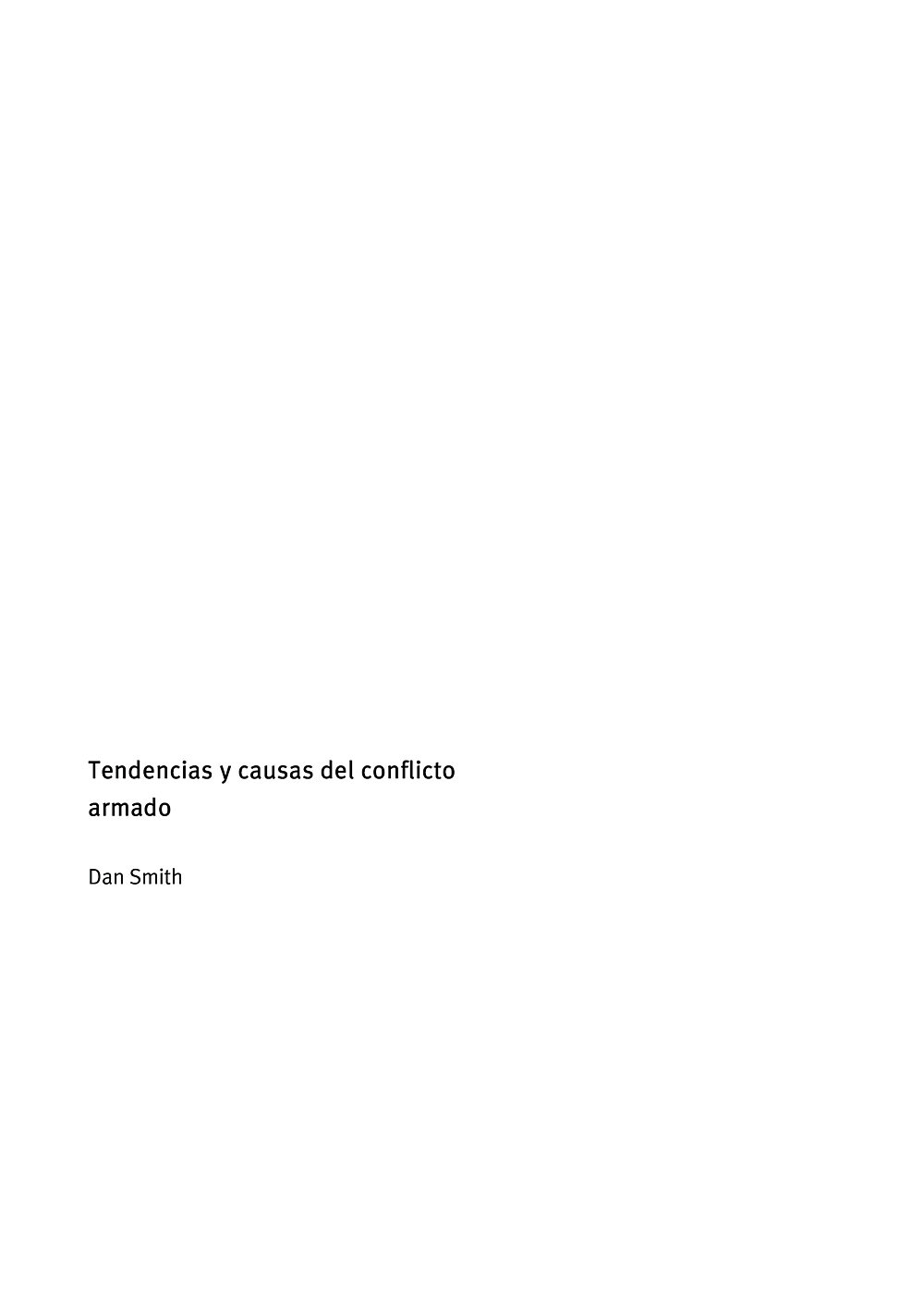
Tendencias y causas del conflicto armadoHandbook Article
[Resumen traducido automáticamente] Ofrece una visión general de los hallazgos actuales sobre las causas de los conflictos armados, identificando la injusticia y la movilización como conceptos clave. El autor comparte ideas sobre dónde buscar señales de una posible escalada, dónde buscar y cómo aprovechar las oportunidades para prevenir una escalada violenta. (revisado para la edición impresa de 2004)
- Year 2002
- Author(s) Dan Smith
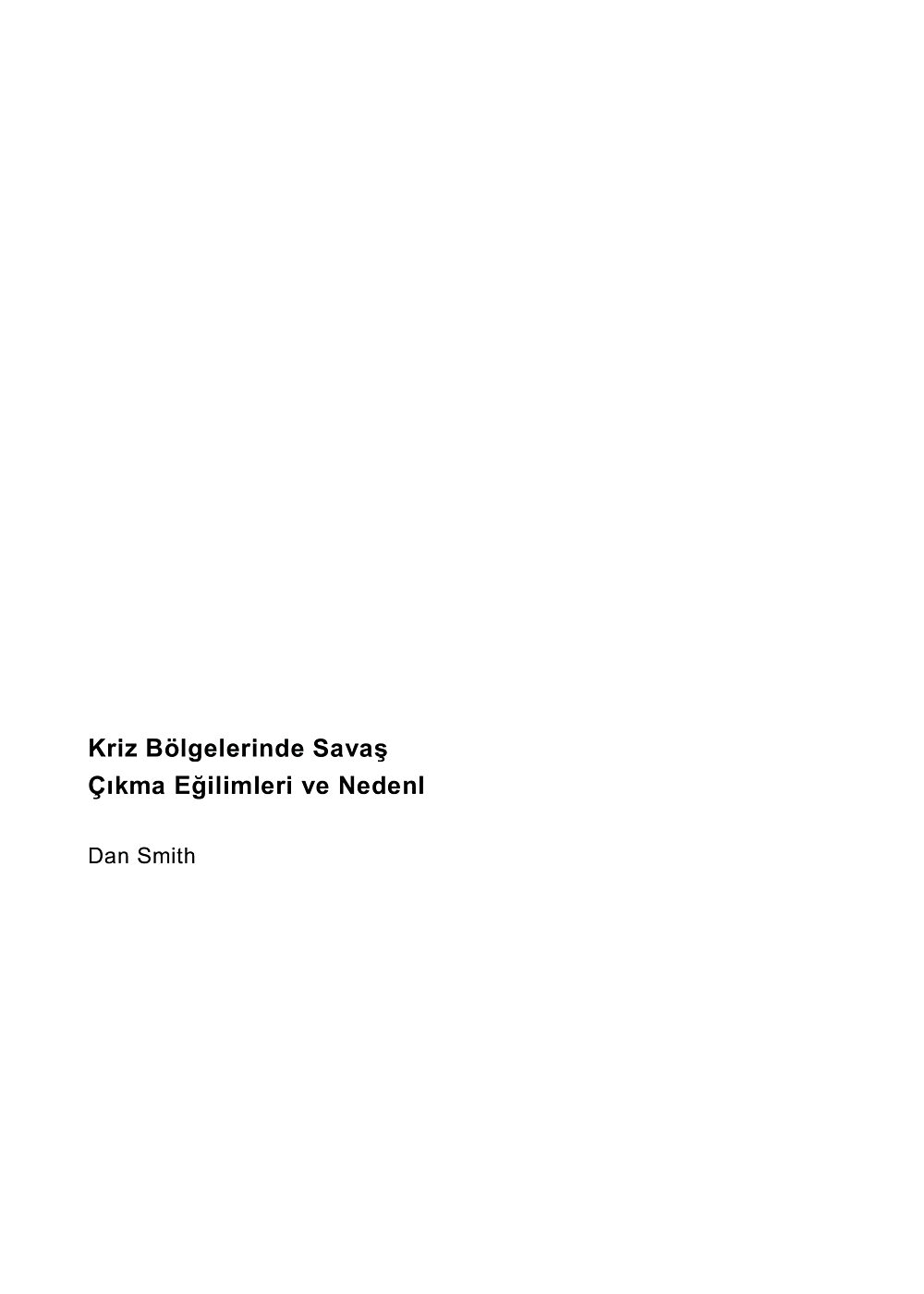
Kriz Bölgelerinde Savas Çikma Egilimleri ve NedenleriHandbook Article
[Özet makine çevirisi] Silahlı çatışmanın nedenleri hakkındaki mevcut bulgulara genel bir bakış sunarak adaletsizliği ve seferberliği anahtar kavramlar olarak tanımlar. Yazar, potansiyel tırmanma belirtilerinin nerede aranacağına, nerede aranacağına ve şiddet içeren tırmanışı önlemek için fırsatlardan nasıl yararlanılacağına dair içgörüler paylaşıyor. (2004 baskı baskısı için revize edildi)
- Year 2002
- Author(s) Dan Smith